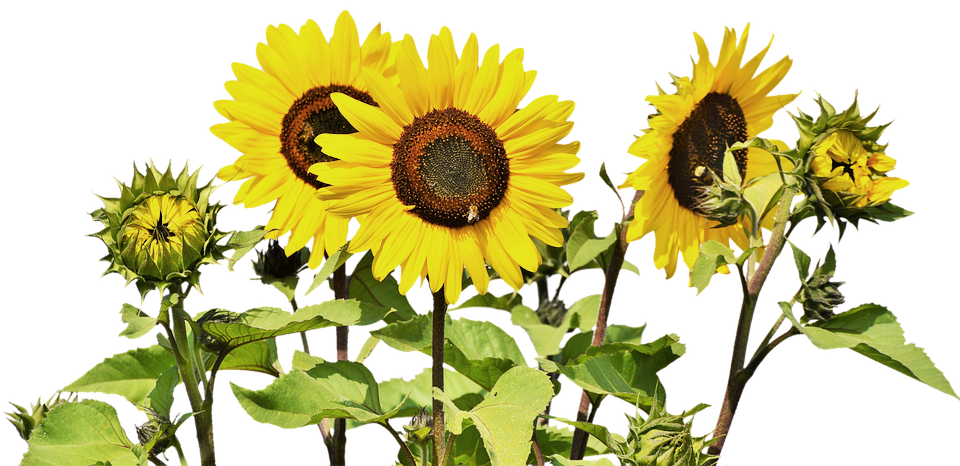
Container Garden University: Compatibility
By Chris Edmunds
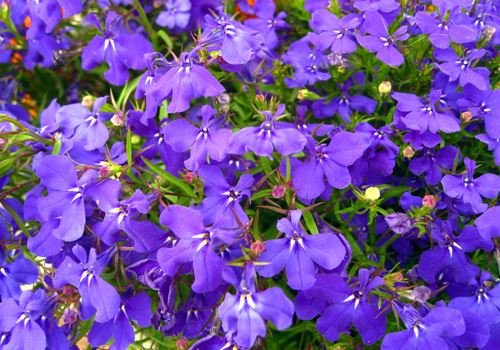
True confessions: Early in my container planting experiments at home, I once planted Cyperus grass “King Tut” in a very large pot and, because I have to make combos out of everything, I planted lobelia around the base, thinking such sweet little blue flowers would complement the tall emerald green fronds of “The King”. Well of course, by July the lobelia couldn’t compete for the water ol’ Tut was guzzling and croaked. I kind of expected this, and just removed the lobelia carcassas and my King Tut became an amazing 5’ tall beauty which I thoroughly enjoyed until he froze in the fall.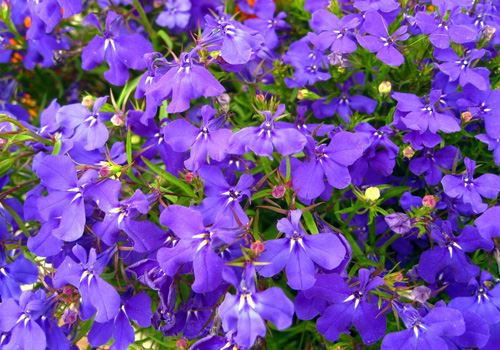
But I was going to be punished for putting this thug in my big beautiful ceramic pot with those poor little defenseless lobelias. The next spring when I went to prepare my pot for spring, I was in for the fight of my life. First, I practically broke my fingers trying to dig into the soil, it was rock hard with roots. My trowel didn’t get anywhere either, so I got mentally prepared and was simply going to pull the whole root ball out. I saw I might have a little problem because my pot curved inward at the top, which meant the whole root ball couldn’t just slip straight out, the soil along the pot walls would need to be loosened and broken up. I thought “ok, I’ll just stab a screwdriver along the edges to break the root ball up”. So I get a screwdriver out and began my attempt. The screwdriver just bounced off like a pogo stick, and I have a pretty wicked right arm muscle! I wasn’t about to give up... time for a shovel. I tried to push it in with one foot on the ground and one foot on the shovel in the pot. I’m kind of short so this wasn’t going to work, so I crawl up onto the pot and, using a wall to steady myself, I jump with both feet onto the shovel. NOTHING! It doesn’t even go in an inch. I try several times, I’m getting worn out and angry, and I’m a little stubborn. Out comes the axe and a pointy tipped hand saw! Finally, I’m getting a few dents made with the axe and try alternating with some sawing action. Well, after my muscles were giving out and my anger and frustration full blown, I dealt the final blow which solved my problem. I missed and broke my pot in two!
I scowl at King Tut now. He’s beautiful but what a brute! He goes in the ground from now on.
But container gardening is really not that hard and here is some tips I hope will help...
Compatibility Matchmaking
Creating a good container involves being a good matchmaker. Your first impulse might be to find your favorite plants that catch your eye and put them together into a container that seems perfect, only to be disappointed later when your plants don’t perform their best.
The best containers are about matching your plants in more ways than just how they look. While most of the fun is in picking colors and textures you love, in order to have a successful container you’ll have to think about the compatibility of your plants - do they have similar needs for sun or shade? And are they going to play nicely with each other?
The plants you see in Kaw Valley stores come from all around the world. Each of them has a different evolutionary background, growing in different conditions and with different behaviors that help them survive. Plants are used to fighting for precious light and water resources, and they have each developed methods that work well in their native homes.
Your container is a closed system, often with cramped quarters! While your beautiful displays of flowers seem docile from the outside, inside the container there is a heated battle for survival going on.
Fighting for Survival
Your beautiful container displays are the result of savage competition--whatever plants spread their leaves the fastest, grow their roots the deepest, and bloom the quickest are the healthiest and most likely to attract pollinators. Your colorful and innocent flowers are actually gladiators battling it out for territory and the resources they need to thrive, and you reap all the benefits of beautiful and lush displays of flowers and foliage as a result.
This competitive spirit is what makes planning for compatibility just as important as matching watering schedules when you plant. Imagine setting a tiny 90-pound gladiator against a 270 pounder - it isn’t going to end up well for one of those fighters. If you set similar fighters against each other, you’ll have a more interesting and longer-lasting main event. The same works for your plants - you will always have competition in your containers, but a successful planter matches compatibility so that everything remains in balance.
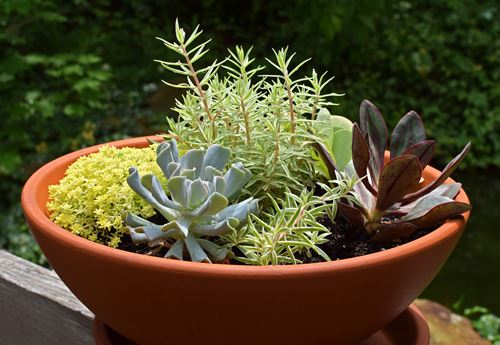 Types of Plants
Types of Plants
Plants are usually put in three categories to label where they are on the scale of competitiveness. You don’t have to be afraid of aggressive plant species! Another word for “aggressive” is “vigorous,” a valued trait. Many of them make for beautiful plants in a container. The more important thing to take away from these plants is the knowledge that you need to match them properly.
Assertive plants sit in the middle of the spectrum. These plants are more flexible and can be planted peacefully in containers with either aggressive or passive plants, as long as you can keep the scissors handy for rescues on occasion.
Passive plants are in the last category. These grow slower and are usually smaller in habit, or they just grow much slower early in the season and get overpowered before they have a chance to catch up with the faster growers.
Aggressive Plants:
These are your fast-growing container stuffers. They can be downright imperialistic and want to grow quickly to cover as much space as they can. This can be a great bonus and the advantage of many annuals who only have one season to really dazzle you.
You can safely assume that most of the high-performance annuals (varieties we sell in pints) are aggressive plants. “Thrillers” such as Sun Coleus and Argyranthemum (‘White’ or ‘Golden Butterfly’) and “Spillers/Fillers” such as Petunias, Bacopa, Verbenas, Sweet Potato Vine, Bidens (Sunbeam), and Purslane fall into this category. ‘White Licorice’, a trailing silver leafed beauty is very aggressive as are annual vines and tropical vines. Many types of grasses are also aggressive (we love ‘Blue Arrows” Juncus for a silvery vertical “Thriller”). Besides the aforementioned ‘King Tut’ (use a straight-sided pot), are very large and aggressive “Thrillers” such as Hibiscus ‘Mahogany Splendor’, Cannas, Purple Fountain Grass, and Eucalyptus ‘Steel Tower’.
Assertive Plants:
These plants will put up a good fight for their fair share of space but aren’t as bent on world domination as the aggressive varieties. If you leave them with a passive or aggressive plant you might end up with someone on the losing end as they get muscled out of the way. With a little bit of supervision, they can work out very well and make beautiful containers. If a faster grower is starting to take over, trim it back especially around the slower grower to give room for the slower grower to catch up and to keep the faster grower in proportion. If you are not experienced cutting back plants, do not cut more that a third of the plant’s top ends off, and be sure there are plenty of leaves left below where you cut. There are a few plants, like Gerber daisies and Caladiums (Elephant Ears), where the plant’s habit is such that all of the leaves come out at the base of the plant, and it doesn’t have a main stem with multiple branches. These should probably be left alone. About all you can do is remove a few leaves from the outer edge of the “clump”, and as long as you don’t remove more than 25% of the leaves they should be ok. It is always best to cut back a plant in the morning or evening when it’s cooler to prevent shock.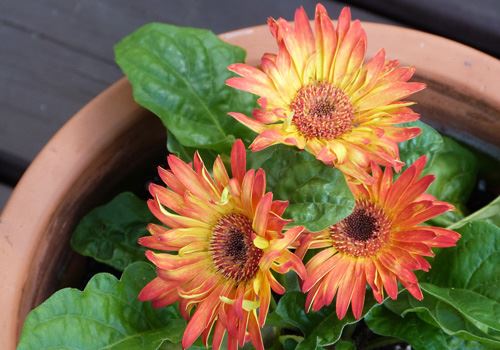
Some examples of assertive plants are annuals like Calibrachoa (Million Bells), Scaevola (Fan Flower), and Osteospermum (African/Cape Daisy). Certain foliage trailing varieties like ‘Purple Queen’ Setcreasea, variegated Vinca Vine and Ivy plants such as ‘Gloire de Marengo’ would also fit this catagory. Lantana and Angelonia (Summer Snapdragon) also fit this catagory, but are a little slower growing until the true heat sets in. They normally won’t get crowded out, but may take longer to show off and get in proportion to your other plants. Lantana’s vary in size, from huge bushes to short and compact, so it’s wise to check the tag or our website to know what you can expect.
Passive Plants:
These plants are also possible to use, but because they have a slower growth rates or just a smaller plant size, they have a harder time competing with the big guys. Passive plants can make a beautiful addition to your container but don’t count on them to survive the whole season when planted with assertive or aggressive varieties. Some people use passive plants knowing they will probably die out (just like landscapers plant summer show-offs between tulips or pansies) and enjoy them while they last. Their demise gives more room for the beefier plants to show off later in the season, just be sure to pull or cut them out when they start looking rough so the overall look of your container stays fresh. Some examples of passive plants are Lobelias (though the varieties sold in pints have a much better chance of survival than ones sold in packs), some herbs (thymes, lavenders, oregano) and some seed grown plants usually sold in packs - like alyssum and vinca (periwinkle).
Modern container designs have made it trendy to mix up your container ingredients with houseplants, tropicals and edibles. This can work beautifully, but be sure the growth rates and sun/shade requirements match. Succulents are some of our favorite passive plants, but most have slow growth rates and are better off by themselves or mixed with other succulents or cacti.
Let the fun begin!!
One of our favorite things about containers is how much choice there is out there, so you can be creative and put something together that is perfect for you. Guidelines don’t need to mean that you can’t have any fun with your choices; they are simply about setting you up to have the beautiful container you want, successful and healthy all summer. If you’re unsure about whether two plants will be compatible together, drop by our garden center in Lee’s Summit and ask one of our experts.
You can find pictures and info about all the plants mentioned in this article at http://www.kawvalleygreenhouses.com/plants.

